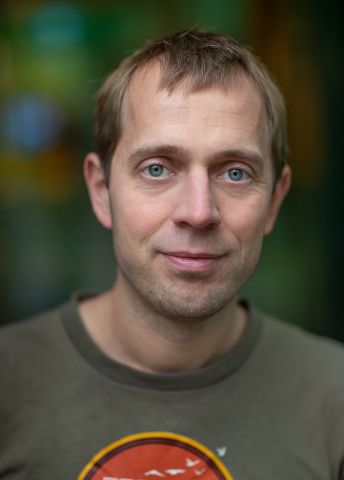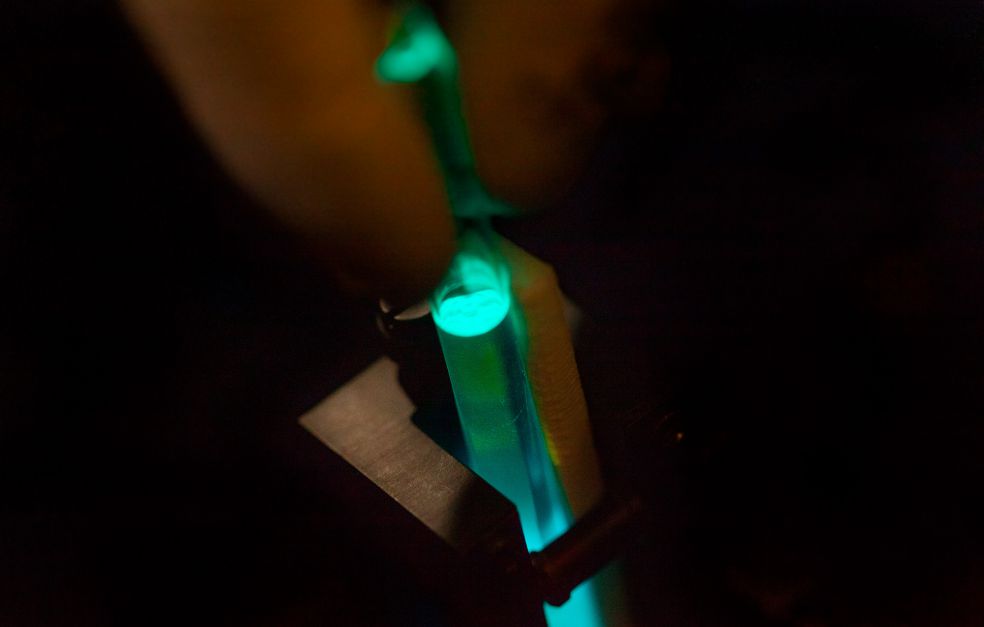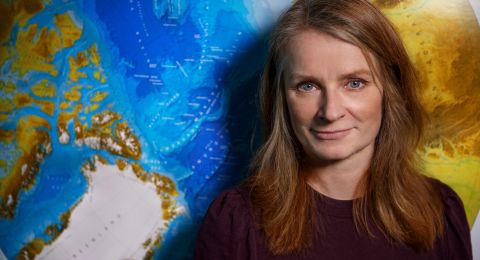By getting energy to bounce back and forth in a nanoscale mirror system, Wallenberg Academy Fellow Karl Börjesson wants to obtain more light from molecules for LED applications, among other things. But first he has to build molecules with exactly the right properties.
Karl Börjesson
Professor of Physical Chemistry
Wallenberg Academy Fellow prolongation grant 2022
Institution:
University of Gothenburg
Research field:
Synthesis of complex molecules for use in materials science. Photophysical/electrical characterization of molecular systems.
Börjesson’s research may lead to better LEDs. But he’s actually working on something quite different.
“We’ll never build an LED here. But the systems we build are made in the same way as organic LEDs – so they may be used in them. Maybe in lasers, too,” says Börjesson, who is based at the University of Gothenburg.
Anyone buying a TV in recent years will undoubtedly have come across organic light-emitting diodes, or OLEDs, as they are usually known. Their main use is in screens, since they are more efficient than normal LEDs.
But paradoxically, OLEDs will only work properly if they are not completely organic. In chemistry, the term “organic” normally refers to something containing carbon and hydrogen. OLEDs do contain organic molecules, but also atoms of a heavy metal. This is because the properties of organic molecules are not really suited to LED technology.
LEDs need heavy metals
When current flows in LEDs, the molecules become energized – excited. When the molecules return to their original state, their excess energy is emitted in the form of light. But this will only work with organic molecules if the excited state has the right spin. This is a property in quantum physics that cannot really be likened to anything in our daily lives.
The commonest states are called singlet and triplet states; in organic molecules only the singlet state can emit light. But only a quarter of the excited states in LEDs are singlets. So three-quarters of the electrical energy would be wasted if it were not for the heavy metal. The metal makes it possible for light to be emitted from the triplet state as well, thereby obtaining more light from the LED. But emission from the metal atoms is a little too slow, and is therefore sub-optimal. And heavy metals are rare, expensive and toxic.
Quantum mechanics between mini-mirrors lets more light shine
This is where Börjesson’s research comes into the picture. He is trying to develop a way of converting triplet into singlet state. He has created a system with two mirrored surfaces separated by a thin layer of organic molecules into which he projects light. The singlet state then begins to emit light, which bounces back and forth between the mirrors. If the distance is exactly right, quantum mechanical effects occur that can be exploited. This is known as strong exciton-photon coupling. The energy for the excited singlet state can then be manipulated so that the triplet exciton becomes a singlet.
“My ultimate goal is to be able to emit light at high velocity and in a controlled way from any energy level in a molecule, preferably also in a predefined direction,” Börjesson says.
The challenge is to develop organic molecules that fit between the mirrors. The molecules need to be some kind of colorant, since colorants have the ability to absorb and emit light. Börjesson is working to alter dye molecules so the method will work. This is needed because the system requires extremely high concentrations, which causes undesirable effects. The molecules may form crystals, for example, or acquire other properties that are incompatible with the system.
“I’m the only researcher developing optimized colorants for this specific purpose. Since we depend on the colorants as an active material, this is my strength as compared with other research teams.”
“Being chosen as a Wallenberg Academy Fellow means an awful lot to me. In purely financial terms, it means I can add to my array of instruments, which is important in the long term. But otherwise it’s mostly a question of recognition. It gives me greater security, and increases my importance to the university. I now have tenure, which wasn’t the case a year ago. It’s a good feeling.”
Never planned to be a researcher
When Börjesson was a small boy, he loved to play with Lego and Meccano. He and a friend of his also took an old TV to bits. When he later made educational choices, it was a foregone conclusion that science and technology would be on the agenda.
“I took a degree in engineering, and I saw ahead of me a career in industry. I never considered research – I didn’t even know what a PhD student was. But by the time I had written half of my thesis, I realized how much I was enjoying myself – I wanted to continue.”
Börjesson likes it best of all when something unexpected happens – an event that no one could have predicted, but that can nonetheless be explained. Another aspect of research that he considers both important and enjoyable is recruiting and supervising PhD students:
“After all – writing a doctoral thesis is an education. When I take on a PhD student, you might say that I am using my research funds to pay for someone’s education. If the research topic doesn’t work out, it is my responsibility to have a reserve topic. But whatever the result, I can feel I’ve done something to be proud of – I’ve helped to educate another person.”
Text Lisa Kirsebom
Translation Maxwell Arding
Photo Magnus Bergström






